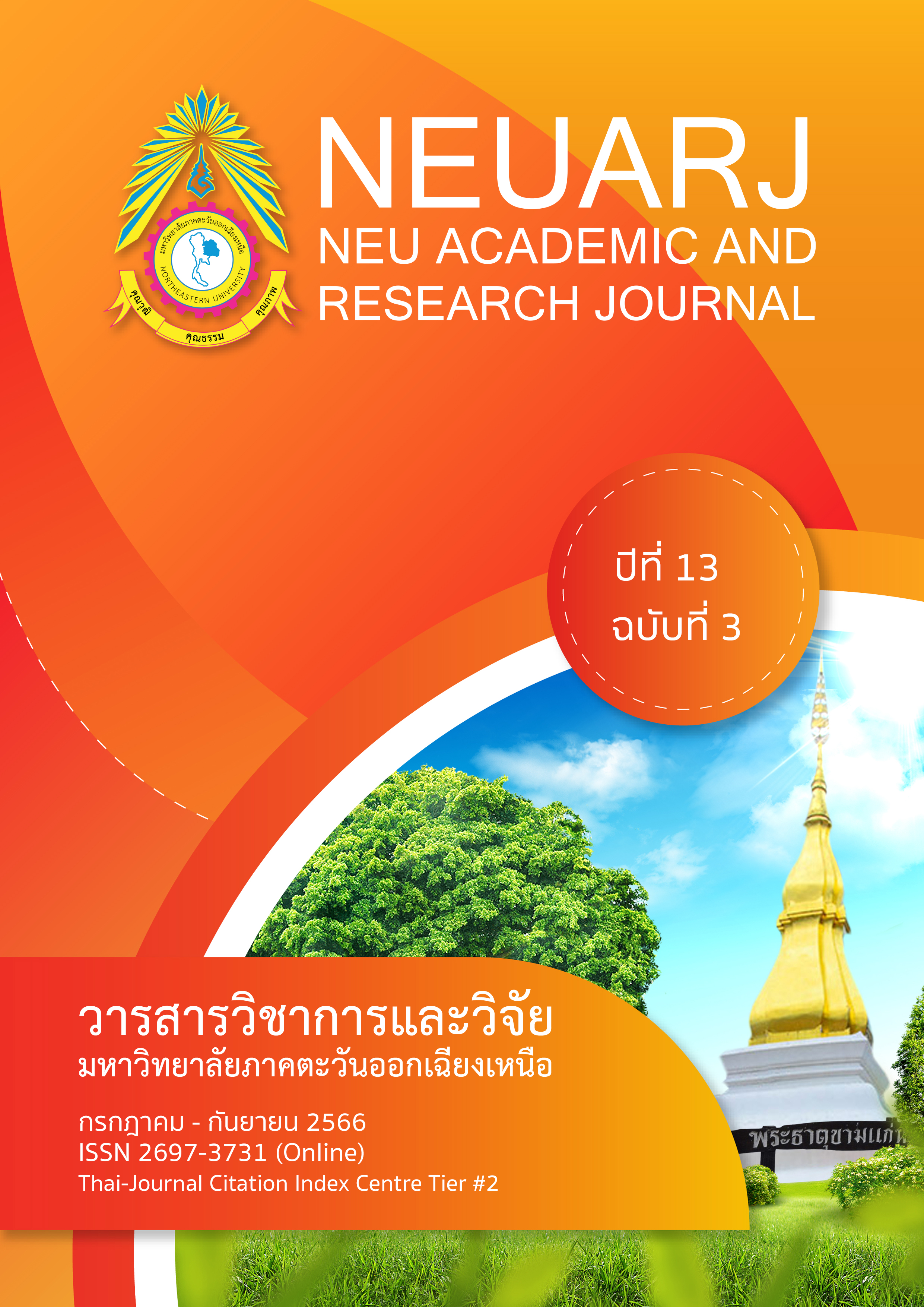The Impact of Innovation E-marketing on Operational Efficiency of Tourism Community Enterprises in Upper Northeast Region 1
Keywords:
Marketing innovation, E-marketing, Operational EfficiencyAbstract
This research aims to investigate the impact of electronic marketing innovations on the operational efficiency of community tourism enterprises. The sample group consists of 400 entrepreneurs engaged in community tourism businesses in the upper Northeastern region of Thailand. The research tools used include questionnaires, assessed for their reliability using Cronbach's alpha, and multiple regression analysis to analyze the data. The data will be analyzed using percentages, multiple regression analysis to examine the relationships between variables, and the coefficients of determination.
The research findings indicate that there is a statistically significant correlation (at the 0.01 level) between electronic marketing innovations, social media marketing, mobile commerce, and the operational efficiency. Furthermore, the design of the user interface also has a positive and statistically significant impact on operational efficiency (at the 0.05 level).
References
จีณัสมา ศรีหิรัญ, ฉัตรวรุณ ศรีนาค, กวินทิพย์ เพ็งมีศรี, เปรมนีย์ ขำคม, และ กนกภรณ์ ครุฑภาพันธ์. (2565). นวัตกรรมการตลาดดิจิทัลของธุรกิจโรงแรม. วารสารวิชาการการตลาดและการจัดการ มหาวิทยาลัยเทคโนโลยีราชมงคลธัญบุรี, 9(2),1-16.
ฉัตรชัย อินทสังข์, สายสวาท โคตรสมบัติ, และ ดารณี เกตุชมภู. (2564). อิทธิพลการตลาดดิจิทัลที่มีต่อผลการดำเนินงานกิจการของโรงแรมในประเทศไทย. วารสารมนุษยศาสตร์และสังคมศาสตร์ มหาวิทยาลัยนครพนม, 11(3), 83-99.
ชฎารัฐ ขวัญนาค และ ศรายุทธ อินตะนัย. (2566). อิทธิพลของการยอมรับเทคโนโลยี และการรับรู้คุณค่าของเว็บไซต์ที่มีต่อการตัดสินใจซื้อของผู้บริโภคในพาณิชย์อิเล็กทรอนิกส์แบบธุรกิจกับผู้บริโภค. วารสารวิชาการและวิจัย มหาวิทยาลัยภาคตะวันออกเฉียงเหนือ, 13(2), 89-103.
วัสสาน์ วิเศษโกสิน และ อำภาศรี พ่อค้า. (2565). กลยุทธ์การตลาดแบบส่งอาหารถึงที่และความสำเร็จทางการตลาด ของผู้ประกอบการอาหาร ในพื้นที่จังหวัดกาฬสินธุ์. วารสารวิชาการและวิจัย มหาวิทยาลัยภาคตะวันออกเฉียงเหนือ, 12(3),70-88.
Alzoubi, H., Alshurideh, M., Kurdi, B. A., Akour, I., and Aziz, R. (2022). Does BLE technology contribute towards improving marketing strategies, customers’ satisfaction and loyalty? The role of open innovation. International Journal of Data and Network Science, 6(2), 449-460.https://doi.org/10.5267/j.ijdns.2021.12.009.
Chong, W. K., Man, K. L., and Kim, M. (2018). The impact of e-marketing orientation on performance in Asian SMEs: a B2B perspective. Enterprise Information Systems, 12(1), 4-18.https://doi.org/10.1080/17517575.2016.1177205.
Díaz, G. R. (2017). The influence of satisfaction on customer retention in mobile phone market. Journal of Retailing and Consumer Services, 36, 75-85.https://doi.org/10.1016/j.jretconser.2017.01.003.
Duhaylongsod, J. B., and De Giovanni, P. (2019). The impact of innovation strategies on the relationship between supplier integration and operational performance. International Journal of Physical Distribution & Logistics Management, 49(2), 156-177.https://doi.org/10.1108/IJPDLM-09-2017-0269.
Felix, R., Rauschnabel, P. A., and Hinsch, C. (2017). Elements of strategic social media marketing: A holistic framework. Journal of business research, 70, 118-126.https://doi.org/10.1016/j.jbusres.2016.05.001.
Hartono, R., and Sheng, M. L. (2016). Knowledge sharing and firm performance: the role of social networking site and innovation capability. Technology Analysis & Strategic Management, 28(3), 335-347. http://dx.doi.org/10.1080/09537325.2015.1095289.
Ibáñez-Sánchez, S., Casaló, L. V., Flavián, M., and Belanche , D. (2022). Influencers and brands successful collaborations: A mutual reinforcement to promote products and services on social media. Journal of Marketing Communications, 28(5), 469-486.https://doi.org/10.1080/13527266.2021.1929410.
Jiao, H., Yang, J., Zhou, J., and Li, J. (2019). Commercial partnerships and collaborative innovation in China: the moderating effect of technological uncertainty and dynamic capabilities. Journal of Knowledge Management, 23(7), 1429-1454.https://doi.org/10.1108/JKM-10-2017-0499.
Khwunnak, C., and Chailom, P. (2021). Impact of Innovation on Operational Efficiency of Tourism Community Enterprises in Thailand. International Journal Of Computing and Digital System, 11(1), 791-799.
Kraus, S., Schiavone, F., Pluzhnikova, A., and Invernizzi, A. C. (2021). Digital transformation in healthcare: Analyzing the current state-of-research. Journal of Business Research, 123, 557-567. https://doi.org/10.1016/j.jbusres.2020.10.030.
Li, G., Li, N., and Sethi, S. P. (2021). Does CSR reduce idiosyncratic risk? Roles of operational efficiency and AI innovation. Production and Operations Management, 30(7), 2027-2045.https://doi.org/10.1111/poms.13483.
Melović, B., Jocović, M., Dabić, M., Vulić , T. B., and Dudic, B. (2020). The impact of digital transformation and digital marketing on the brand promotion, positioning and electronic business in Montenegro. Technology in Society, 63, 101425.https://doi.org/10.1016/j.techsoc.2020.101425.
Ramanathan , R., Ramanathan, U., and Zhang, Y. (2016). Linking operations, marketing and environmental capabilities and diversification to hotel performance: A data envelopment analysis approach. International Journal of Production Economics, 176, 111-122.https://doi.org/10.1016/j.ijpe.2016.03.010.
Santa, R., MacDonald, J. B., and Ferrer, M. (2019). The role of trust in e-Government effectiveness, operational effectiveness and user satisfaction: Lessons from Saudi Arabia in e-G2B. Government Information Quarterly, 36(1), 39-50.https://doi.org/10.1016/j.giq.2018.10.007.
Sârbu, R., Alecu, F., and Dina, R. (2018). Social media advertising trends in tourism. Amfiteatru Economic, 20(12), 1016-1028.https://doi.org/10.24818/EA/2018/S12/1016.
Streiner, D., and Norman, G. (1995). Health Measurement Scales: A practical guide to their development and use (2nd ed). Oxford: Oxford University Press.
Wang, G., Gunasekaran, A., Ngai, E. W., and Papadopoulos, T. (2016). Big data analytics in logistics and supply chain management: Certain investigations for research and applications. International journal of production economics, 176, 98-110.https://doi.org/10.1016/j.ijpe.2016.03.014.
Yamane, T. (1973). Statistics: an introductory analysis. New York: Harper and Row.
Yu, L., Duan, Y., and Fan, T. (2020). Innovation performance of new products in China's high-technology industry. International Journal of Production Economics, 219, 204-215.https://doi.org/10.1016/j.ijpe.2019.06.002.

Downloads
Published
How to Cite
Issue
Section
License
Copyright (c) 2023 NEU ACADEMIC AND RESEARCH JOURNAL

This work is licensed under a Creative Commons Attribution-NonCommercial-NoDerivatives 4.0 International License.


